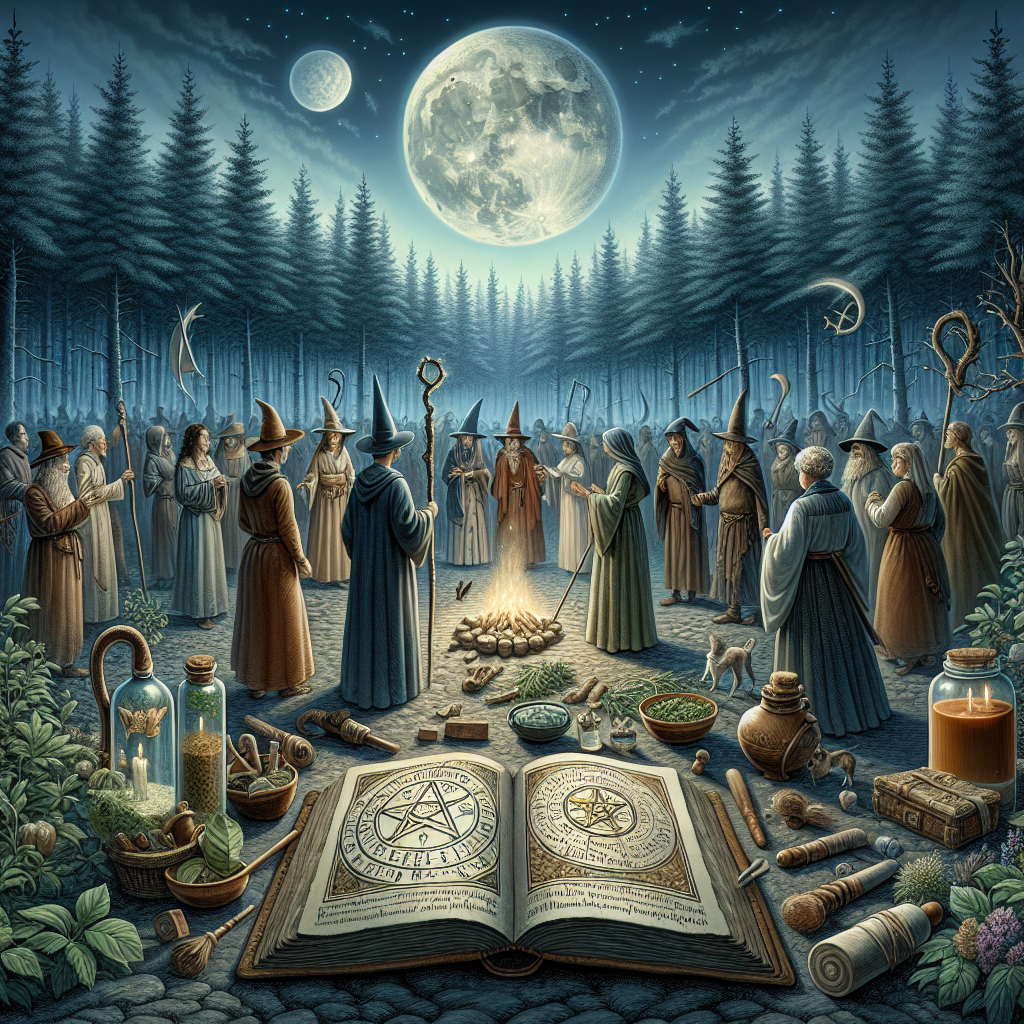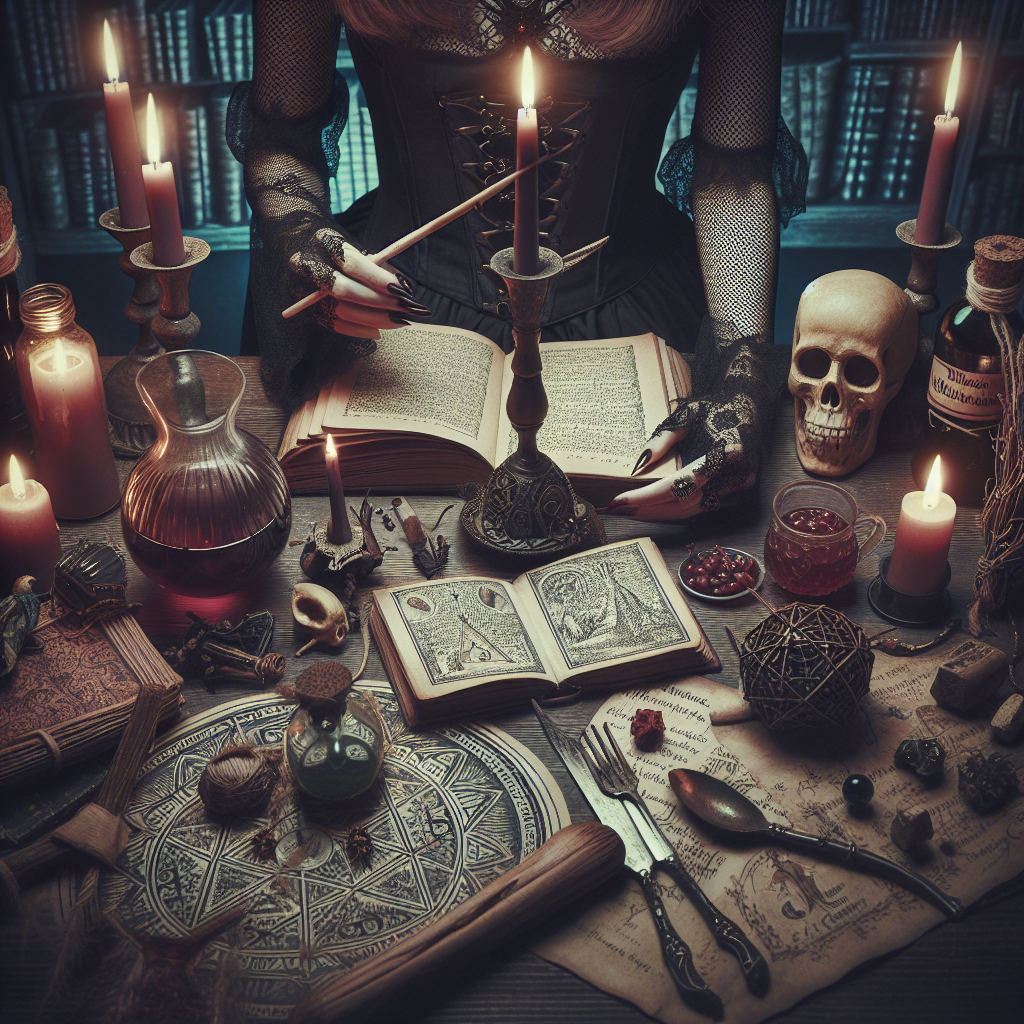As an Amazon Associate I earn from qualifying purchases.
Every year in Europe, during the sixteenth and seventeenth centuries, hundreds, even thousands of people – predominantly women – were persecuted, tortured, and executed on the charge of witchcraft. This dark historical past forms the basis of “Tracing the Arcane Path: A Journey Through Witchcraft History,” a comprehensive study that seeks to unravel the mysteries, superstitions, and fears that perpetuated the witch hunts and the inherent gender discrimination of such a volatile epoch.
“Tracing the Arcane Path: A Journey Through Witchcraft History” is a remarkable endeavour charting the profound and tempestuous history of witchcraft from ancient times to modern practices. Its exploration delves beyond the infamous witch-hunts of the Middle Ages and the arcane rituals of the ancient world. The work is an invaluable resource for understanding the complexities of our own historical narrative, considering that belief in witchcraft and the supernatural is far from extinct; a 2005 Gallup poll revealed a staggering 21% of Americans believing in witches.
The book’s meticulous study meticulously traces the evolution of witchcraft: from its conception in the ancient world where it commonly represented a way to explain natural phenomena, through to the Middle Ages where the Christian demonization of pagan beliefs sowed the seeds of the witch-hunts. The journey extends to the European witch trials, a horrific period that saw the loss of thousands of purported witches, and the ensuing societal and judicial reforms that brought an end to such practices.
From an intriguing perspective, “Tracing the Arcane Path: A Journey Through Witchcraft History” highlights the gender dynamics associated with witchcraft, specifically the vilification of women. It demonstrates how assumed characteristics of femininity such as hysteria, mood swings, or even natural biological processes were exploited and twisted by fear, ignorance, and misogyny to accuse and persecute supposedly witchy women. Societal fear was deep-seated, with one treatise from 1486, the Malleus Maleficarum or “Hammer of Witches”, brazenly stating that, “All witchcraft comes from carnal lust, which in women is insatiable.”
But witchcraft was not solely an instrument of fear and persecution. The historical narrative also charts the spiritual and cultural significance of witchcraft in societies across time and space. Indigenous communities have frequently used witchcraft as a tool for societal regulation, appeasing the gods, or influencing natural phenomena. The book makes a point to highlight this layered representation of witchcraft history, painting a much broader and complex picture that resonates with the reader’s comprehension of cultural diversity.
In the modern era, “Tracing the Arcane Path: A Journey Through Witchcraft History” investigates the rising trend of neo-pagan religions such as Wicca, which integrate aspects of witchcraft into their beliefs and practices. A recent study published in Trinity College in Hartford, Connecticut, discerned that Wicca had increased exponentially, from an estimated 8,000 practitioners in 1990 to an astounding 340,000 self-identified Wiccans in 2008. The book thereby bridges the gap between historical perceptions of witchcraft and its contemporary incarnation.
What Is the History of Witchcraft? Tracing The Arcane Path Through Ages
The study of witchcraft history is synonymous with a journey, ‘The Arcane Path’, tracing the socio-cultural evolution of societies that regarded magic as essential and those who classified it as heresy. The history of witchcraft chronicles this journey, highlighting periods marked by mysterious rituals, sorcery, societal hysteria and witch hunts. This encompasses the early tribal practices of shamanism, the witch trials of the Medieval and Renaissance periods, right up to modern-day neo-pagan movements such as Wicca. Examining witchcraft history uncovers not only the mystical practices but also the perceptions and misconceptions of the society in question, contributing to our knowledge of human fear, ignorance, tolerance, and faith. Stay with us as we delve deeper into this spellbinding chronicle in the next segment.
Tracing the Arcane Path: A Journey Through Witchcraft History
The annals of witchcraft history are filled with fascinating stories of unusual rituals, powerful spells, and individuals who’ve been both revered and prosecuted for their connections to the magical arts. Diving into the history of witchcraft requires a deep and nuanced understanding. This path delves into ancient cultures, diverse interpretations, and the complex perception society has about witchcraft.
Early Beginnings
The history of witchcraft goes back as far as the Paleolithic period, circa 40,000BC. Early cave art depicted scenes of regular human existence coinciding with the spirit world, featuring drawings of half-human, half-animal shamans in the midst of conjuring. During the Classical period, witchcraft was well-documented in the works of literature by Homer, Virgil, and Ovid. The perception of witchcraft was intertwined with basic human understanding of the world; gods, witchcraft, and human existence were seen as interconnected.
Medieval Times
As we trace the witchcraft history through medieval times, the perception shifted markedly. During the Middle Ages, witchcraft came to be associated with evil, with societies heavily influenced by Christianity viewing witches as cohorts of the devil. The most prominent manifestation of this belief was the Inquisition, launched in the 13th century, intensifying fear of witchcraft and leading to bloody witch hunts, including the infamous Hammer of the Witches.
The Renaissance and Beyond
Witchcraft during the Renaissance saw a spark of scientific inquiry. With the Intellectual Revolution, interest grew in the study of the metaphysical world. Witch trials became less rampant, although the fear of witches never entirely disappeared. It was in this era that the notorious Salem Witch Trials of 1692 took place in colonial America.
Today, the term “witch” has come to be more widely respected and better understood. Witchcraft now mostly refers to Wicca, a modern, nature-based spiritual practice with roots in ancient paganism. Wiccans, or witches, are now free to practice their craft openly and enjoy the right to religious freedom.
Statistics
According to the Pew Research Center, Wicca has significantly grown in popularity in recent years, with the number of self-identified witches in the U.S. doubling between 1990 and 2008 from around 8,000 to 340,000. However, the path to this acceptance has been a rocky one, with the history of witchcraft marked by misunderstanding, prejudice, and persecution. The rise in numbers signifies an evolving understanding and acceptance of this ancient, spiritual practice.
Tracing the arcane path through witchcraft history unfolds a rich tapestry of cultural, religious, and social constructs. From the earliest cave drawings of shamans to the vilification of witches in medieval times, and the modern acceptance of Wicca, the understanding and significance of witchcraft continue to evolve. This journey through witchcraft history highlights the struggle and evolution of this spiritual practice that has stood the test of time.
1.
What is the origin of witchcraft in history?
The practice of witchcraft can be traced back to the Paleolithic period when humans started painting on cave walls. They drew images of magical beings, suggesting the presence of a belief system involving magic and supernatural powers. However, the understanding and interpretation of witchcraft varied throughout history and from culture to culture.
2.
How has the perception of witchcraft changed over centuries?
Throughout history, the perception of witchcraft has changed significantly. During ancient times, witches were seen as healers or wise people with the ability to perform magic. However, during the Middle Ages and onwards, society’s view turned negative, and witches were increasingly associated with the devil and evil deeds. Today, the understanding of witchcraft is again shifting, with many viewing it as a form of spirituality or paganism.
3.
What led to the witch trials during the Middle Ages?
The witch trials in the Middle Ages were driven by religious and socio-political factors. The church started perceiving witchcraft as heresy, a threat to Christianity, leading to widespread fear, superstition, and ultimately, the inquisition and witch trials. The accused were often women, reflecting gender prejudice prevalent during this era.
4.
What were the humanitarian impacts of the witch trials?
The witch trials led to thousands of executions across Europe and the Americas, creating a climate of fear. These trials often involved torture and other inhumane practices of extracted confessions. The repercussions were immense, as they resulted in affecting entire communities and upsetting demographics due to the large number of women targeted.
5.
How have modern witchcraft practices evolved from their historical roots?
Modern witchcraft, or Wicca, has evolved significantly from historical witchcraft. It emphasizes on harmony with nature, belief in the power of the self, and the use of magic for positive change. It has evolved into a diverse and liberal religious movement that respects free will and strives for balance and harmony.
6.
What was the influence of ‘Malleus Maleficarum’ on witchcraft history?
Malleus Maleficarum’, or ‘The Hammer of Witches’, played a considerable role in demonizing witchcraft during the late Middle Ages. It was a manual for witch-hunters, and it established theological justifications for the persecution of alleged witches, significantly contributing to the witch panic in Europe.
7.
How have witchcraft beliefs influenced contemporary popular culture?
Beliefs about witchcraft have significantly influenced contemporary popular culture, especially in books, movies, and TV shows. They often draw on historical perceptions of witches and witchcraft while also adding new interpretations. Examples abound such as Harry Potter series, The Craft, Charmed, and American Horror Story: Coven.
8.
What is the Salem Witch Trials’ significance in witchcraft history?
The Salem Witch Trials remain one of the most notable instances of mass hysteria over witchcraft. Occurring in the late 17th century in Massachusetts, around 200 people were accused of witchcraft, with 20 executed. They serve as a lesson about the dangers of superstition, false accusations, and lapses in due process.
9.
How was male witchcraft viewed differently than female witchcraft in history?
In many societies, especially during the Middle Ages, male witchcraft was often viewed less negatively than female witchcraft. Mostly, women accused of witchcraft were seen as being in league with the devil. Men, meanwhile, were sometimes seen more as sorcerers or wizards, often thought to use magic for practical or scientific purposes.
10.
Are there still real witches today?
Yes, many people today identify as witches, most commonly within the context of neopagan religions like Wicca. Modern witchcraft is viewed as a legitimate belief system that values nature, practices magic, and often includes a reverence for goddesses in addition to or instead of gods.

Unveiling Witchcraft’s Historic Chronicles
Tracing the Arcane Path: A Journey Through Witchcraft History has vividly unveiled how the perception and enactment of witchcraft evolved across eras, societies, and continents. It underscored the multilayered complexity of witchcraft – from being an integrated part of religious practices in ancient Egypt and Greece, becoming a symbol of evil and devil during the Middle Ages in Europe, until its metamorphosis into an individualistic spiritual path in the modern world. This article further highlighted the differential landscapes that gave birth to witch-hunts – underscoring the interplay of sociopolitical, religious, and economic factors that often used allegations of witchcraft as means to suppress rebellious, non-conformist or marginalized groups, largely women.
In focusing on the contemporary witchcraft scenario, the article underlined how Wicca and other modern witchcraft movements draw from a rich tapestry of older, more diverse traditions, while simultaneously adapting to fit within today’s societal context and religious pluralism. Celebrating nature, feminine divinity, and individual autonomy, it’s become a symbol of empowerment and rebellion against stringent religious dogmas and cultural norms. The analysis also accentuates the increasing acceptance and mainstreaming of witchcraft, a testament to society’s growing openness towards alternate spiritual journeys. Tracing the Arcane Path: A Journey Through Witchcraft History ultimately showed that the history of witchcraft is not just a fascinating exploration of supernatural beliefs, but also a mirror reflecting societal dynamics, power politics, and changing human perspectives.
Amazon and the Amazon logo are trademarks of Amazon.com, Inc, or its affiliates.


